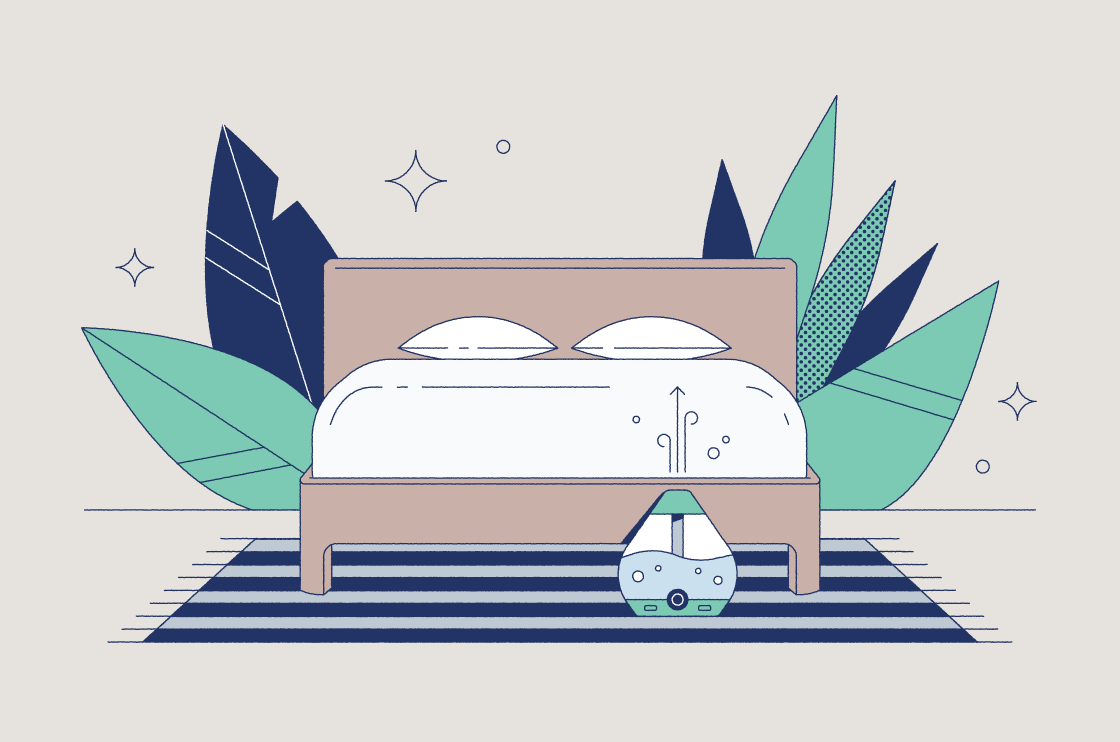Disclaimer: This article is for informational purposes only and should not be taken as medical advice.
Are there days where you wake up and realize you’re oddly sweaty? Damp sheets in the morning might not just be a “you” problem. The culprit could be the humidity levels in your bedroom.
The best humidity for sleep is between 30 and 50 percent. This range supports your best sleep and keeps you healthy while you doze off. It can be difficult to figure out whether you’re sweating because you’re sleeping hot or because the humidity in your room is too high.
Luckily, we’re here to talk about some common signs your bedroom humidity is off and easy strategies to correct it.
What Is the Best Humidity for Sleep?

According to the Environmental Protection Agency (EPA), indoor humidity should range anywhere from 30 to 50 percent. This range might seem like a lot, but that’s because there are many factors that affect a room’s humidity and determine what humidity is ideal for sleeping.
Since ideal humidity varies so much with climate, personal preference, and health concerns, your actual ideal humidity might be a little out of this range. But it’s certainly a starting point if you suspect your room’s humidity is off.
It could be worth investing in a hygrometer, a device used to measure humidity. When measuring humidity, there are two different types:
- Absolute humidity refers to how much moisture is actually in the air
- Relative humidity refers to how much moisture is in the air compared to the maximum humidity for the current temperature
Cold air holds less moisture, so a cold room’s relative humidity will be higher even if the air holds the same amount of water as a warm room. Because of this, it’s more useful to measure absolute humidity to determine ideal sleeping conditions.
According to a research study from Tohoku Fukushi University, exposure to humidity while sleeping decreases REM (rapid eye movement) and SWS (slow wave sleep). Basically, this means poor humidity regulation negatively impacts your sleep quality and shortens precious deep sleep cycles.
How Do I Know if I Need To Adjust My Bedroom’s Humidity?
While a hygrometer is a surefire way to measure your room’s humidity, it might not be helpful for determining whether or not your room is at the right humidity level. Room temperature also affects your room’s humidity, so humidity levels can change throughout the day.
Here are some common red flags you can look out for to see whether you need to increase or decrease your room’s humidity.
Signs you should increase humidity:
- Dry skin or eczema worsens
- Nose or throat irritation occurs
- Nose bleeds develop
- Dry eye develops or worsens
- There is a lot of static electricity
- Wooden features develop cracks
Signs you should decrease humidity:
- Allergies develop or worsen
- Signs of mold or mildew appear
- Sheets feel damp in the morning
- Wall paint bubbles or peels
- Wooden features swell

If left unchecked, poor room humidity can negatively impact your health. Dry air can be uncomfortable and worsen respiratory conditions because it dries out the membranes in your nose and throat.
Solutions like sleep masks, lotions, and sprays can help prevent dry eye, throat, and nose. However, it’s more effective to fix the root of the problem by increasing humidity levels.
Too much humidity also has negative impacts on health. Allergens like dust and mold thrive in high humidity and irritate your respiratory system. High humidity can even worsen asthma because humid air becomes more difficult to breathe in.
If your humidity level is above 50 percent in the long term, you’re particularly at risk of growing mold in your home. Mold exposure can cause many health problems and it can be difficult to get rid of so prevention is key.
The CDC recommends the following measures to reduce your mold risk:
- Keep humidity levels below 50 percent
- Promptly fix any leaks
- Ventilate your home with fans and open windows
- Avoid carpeted floors
If you suspect the humidity levels in your bedroom are impacting your health and sleep quality, it’s best to take action early before things get worse. If you’re worried about your health, get in touch with your doctor for their recommendations about any next steps.
Is it Better to Sleep in a Humid or Dry Room?
For ideal sleep and health, you don’t want your room to be at an extreme humidity level. Much like Goldilocks, you want it not too dry, not too humid, but just right. If you stay within the recommended 30 to 50 percent humidity level, then you shouldn’t need to worry about damage to your health or belongings.
But you’re still going to feel the difference between a 30 and 50 percent humidity level. Let’s talk through some pros and cons so you can decide what level you should aim for.
Sleeping in a Humid Room
Humid rooms are typically closer to a 50 percent humidity level. Moisture in the air is important to help lubricate your airways. In addition to the health effects, there can be cosmetic benefits to sleeping in a room that’s on the humid side.
In cold climates, many people opt to humidify their room, which helps moisturize their skin and hair. In warm climates, it’s very common to struggle with a room that’s too humid, which can damage furniture and cause health issues.
Pros
- Can moisturize skin and hair
- Can improve nose and throat irritation
Cons
- Can worsen allergies or asthma
- Can damage furniture
Sleeping in a Dry Room
Dry rooms are typically closer to a 30 percent humidity level. Researchers at Harvard University found that it’s common for indoor spaces to have a low relative humidity, particularly in colder climates. They also found that even though humidity levels can cause health issues when they’re too low or too high, people notice the side effects of low humidity more.
A humidifier in cold weather can make sleeping more comfortable, as dry airways can make breathing uncomfortable. If it’s not possible to use a humidifier, sprays and lotions can help alleviate this discomfort and moisturize your nose and throat.
Pros
- Can reduce allergies
- Can minimize respiratory risk
Cons
- Can cause dry skin or dry eye
- Can cause nose bleeds
The likelihood of having a bedroom that errs on the too-dry or too-humid side depends on your climate. Consider switching your approach to room humidity based on your climate, preferred room temperature, and sleeping habits.
How to Optimize Bedroom Humidity
Now that you’ve identified if you’re having issues regulating the humidity in your bedroom, let’s discuss some ways you can adjust your room’s humidity to improve your sleep quality.
1. Choose the right bedding
Believe it or not, your bed and bedding affect your room’s humidity. Because your bed usually takes up a larger portion of a room, it can actually change your air quality.
Bedding and sheets made from breathable or natural materials such as cotton or TENCEL™ are ideal if you suspect your bedroom is too humid. These will help you stay comfortably dry while you snooze and can help regulate your room’s humidity levels.
2. Use a Humidifier or Dehumidifier
One of the quickest ways to resolve humidity issues is to purchase an air humidifier or dehumidifier.
- Humidifiers vaporize water into the air to increase humidity levels
- Dehumidifiers pull moisture from the air to decrease humidity levels

A report from Brigham and Women’s Hospital recommends using a dehumidifier to cut down on allergen exposure. According to this report, “the more you are exposed to something to which you have an inherited leaning to be allergic, the more likely you are to become allergic to it. It could be mold, bacteria, or dust mites.” Because dehumidifiers reduce the conditions for these allergens to grow, they may reduce your risk.
Humidifiers and dehumidifiers are both different from air purifiers. While humidifiers and dehumidifiers either add or remove moisture from the air, they don’t have a direct effect on air pollutants.
Air purifiers filter your air and remove pollutants via filters but don’t affect humidity levels. If you feel like you need a combination of these benefits, there are a number of special air purifiers that can also humidify or dehumidify a space on the market.
3. Consider Your Plants
Plants don’t just liven up a space — they can also help you regulate your room’s humidity levels. Most plants introduce humidity to a room, so consider adding more greenery if you think your air is too dry.
If you struggle with a room that’s too humid, consider redistributing your plants evenly around your home or moving some of them outside to reduce humidity levels.
Here are some of our favorite houseplants for your bedroom:
- English Ivy
- Peace Lily
- Golden Pothos
- Snake Plant
4. Use a Mattress Protector
Just like your bedding, your mattress can hold on to moisture if you live in a very humid environment. Water-resistant mattress protectors keep your mattress from absorbing excess moisture and contributing to your humidity issues.
For best results, use one as soon as you can. If your mattress has been sitting in a humid environment for a while, you’ll want to dry it out with fans or a dehumidifier before adding a protector to make sure you don’t seal in moisture, which can lead to mold growth.
5. Adjust Your Heating and Cooling
Heating and cooling systems can also help regulate your home’s humidity. Both heat and air conditioning systems can help reduce humidity levels. Turning these systems up can help decrease humidity as needed, and turning them down can help boost humidity levels.
Proper maintenance is also essential for regulating humidity levels. Make sure you’re cleaning or replacing the filters in your heating and cooling systems regularly for the best results.
6. Improve Circulation
Improved circulation generally helps reduce humidity levels, but this depends on how your indoor humidity compares to the outside or if the humidity varies throughout your home.
While improved circulation is often recommended to decrease humidity levels, strategies like circulating humid air from the bathroom after a warm shower can help give it a boost.
Regardless of your humidity goals, increased airflow can improve your air quality and health, and potentially help protect you against COVID-19.

Perfect Your Sleep Atmosphere with Casper
For your health and sleep’s sake, it’s important to create the perfect environment in your bedroom. Casper’s Mattress Protector and Hyperlite™ Sheets help maintain the best humidity for sleep so you always wake up ready to tackle your day.













